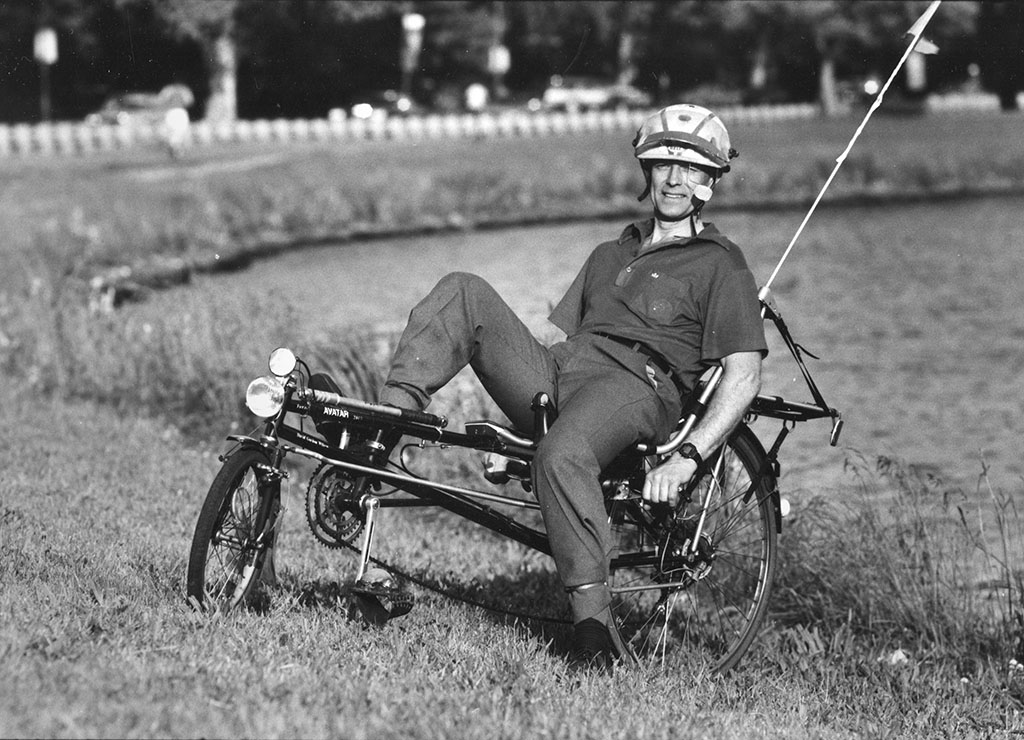Talking Shop: Professor Emeritus David Gordon Wilson
Designer, Inventor, and Author of “The Bike Bible” Discusses His Lifelong Love of the Bicycle
For Professor Emeritus David Gordon Wilson, there is only one way to get to work – on his beloved bike. Cycling has been his preferred mode of transportation since he first rode on two wheels at the age of nine in his native England. This passion for the bicycle helped inspire his decision to pursue a career in engineering.
Over the course of six decades, Wilson’s career has been peppered with many achievements, including inventing the progressive fee-plus-rebate policy in 1973 and designing jet engines. But wherever his career has taken him, his hobby of cycling has followed. Author of Bicycling Science, known as the premiere authority on bicycle design and MIT Press’s best selling book, he was recently invited to work on a fourth edition.
When did your passion for the bicycle turn into an academic pursuit?
In 1967 I organized an international competition, in collaboration with the journal Engineering, for the best design in human-powered land transport. To my amazement seventy-eight people from sixty-four countries entered and it was a great success. At the time I was passionate about getting people interested in different types of bikes, particularly recumbent bicycles. So as the competition carried on, I worked on my own designs for a recumbent bicycle.
What made you interested in designing recumbent bicycles over traditional upright bicycles?
Well, recumbents are faster and safer than regular bikes. Cycling in a reclined position also helps distribute weight more evenly, giving better and safer braking with no danger of going over the handlebars. In the 1970s I started designing recumbents after Fred Willkie asked for designs. This culminated in the Wilson-Wilkie Recumbent in 1975. Our bike became extremely popular in Europe and got some great visibility when it was featured by Mobil for its “Imagination" Series.
One of the recumbent bicycles you designed broke the world record for speed. How did you go about designing a recumbent for speed?
It was important to make the bicycle more aerodynamic to achieve top speeds. In the late 70s, the Fomac Corporation built the Avatar 1000 and Avatar 2000 recumbent bicycles to my designs. The Avatar 2000 was then streamlined in 1982 with a lightweight fairing called Bluebell to make the bike more aerodynamic. That same year, ridden by an Australian lawyer, it broke the world record at the International Human Powered Vehicle Association trials by traveling 51.9 mph. That record has increased greatly in recent years using the flat Highway 305 at an altitude 4,511 feet in Battle Mountain, Nevada: in 2013 team from the Netherlands achieved 83.1 mph.
What do you think has been the biggest advance in bicycle design since publishing the first edition of Bicycling Science in 1974?
Advances in brake and transmission designs have really improved cycling. Gears have a far-wider range than had the old three-speeds and ten-speeds. My wife actually rode 4,000 miles across the country last summer. She also works for The Visiting Nurses and cycles to her patients, often carrying large loads using a 14-speed hub gear that has a gear range over 500%. Another development that has made a big difference in modern bikes is the use of carbon fiber. It makes the structure lighter and stiffer than the steel, aluminum, or titanium used for most bikes. One of my students, David Kindler, made the first fiber wheel for bicycles.
What do you see as the next big thing in bicycle design?
Somebody sent me a wonderful video about the launch of a self-driving bicycle. Of course they sent it on April 1 so it ended up being an April Fool’s Joke. What I would really like to see is for companies to make bikes safer. If any element of the design fails – for example a fork or chain stay breaks – then the cyclist is put in danger. It’s crucial to make safe, light-weight bicycles, especially in sports. The Dutch have taken the leadership in producing enclosed or semi-enclosed cycles called “velomobiles,” giving enhanced safety and weather protection.
Do you see a place for recumbent bicycles in professional cycling?
Absolutely! Something I’ve recommended is for the Tour de France to have recumbents start prior to the regular upright bicycles. It would be very exciting to add this element, since recumbents are not only faster but safer, so you wouldn’t see the domino-style pile-ups that often occur in the Tour de France.
This article originally appeared in the 2017 Spring/Summer Issue of MechE Connects.



